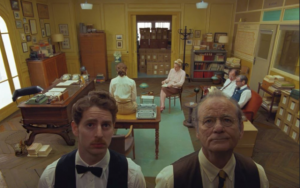THE FRENCH DISPATCH: 2 ½ STARS. “like a bot to watched 1000 hours of Anderson’s films…”
 “The French Dispatch,” now in theatres, is the most Wes Anderson-y film in the Wes Anderson playbook. If you forced a bot to watch 1000 hours of Anderson’s films and then asked it to write a movie on its own, “The French Dispatch” would be the result.
“The French Dispatch,” now in theatres, is the most Wes Anderson-y film in the Wes Anderson playbook. If you forced a bot to watch 1000 hours of Anderson’s films and then asked it to write a movie on its own, “The French Dispatch” would be the result.
Broken into three stories, this is the story of three writers and their work for The French Dispatch, an American owned newspaper supplement edited by Arthur Howitzer Jr. (Bill Murray) from their offices in Ennui-sur-Blasé, France.
On the occasion of Howitzer’s passing the staff assemble to put together a special edition of the paper to honor him. After a quick intro to the paper and the town by Herbsaint Sazerac (Owen Wilson), the movie introduces its first tale, an outlandish take on the birth of abstract expressionism.
Benicio Del Toro stars as Moses Rosenthaler, a temperamental artist incarcerated for double murder. His muse is Simone (Léa Seydoux), the guard of his cell block. When his work is discovered by art dealer Cadazio (Adrien Brody), who happens to be doing time for financial improprieties, Moses reluctantly becomes a worldwide sensation.
Next is “Revisions to a Manifesto,” Anderson’s take on the French May 1968 student uprising. French Dispatch reporter Lucinda Krementz (Frances McDormand) covers the story of wild-haired Zeffirelli (Timothée Chalamet), the revolutionary Juliette (Lyna Khoudri) and the manifesto they want to present to the world.
The final story involves food critic Roebuck Wright (Jeffrey Wright). He recounts how a food prepared by brilliant police chef Nescaffier (Stephen Park) foiled the kidnapping of a police commissioner’s son.
Fans of Anderson’s work know what to expect. Perfectly composed shots, Bill Murray and fussy, idiosyncratic situations and dialogue. Aficionados will not be disappointed by “The French Dispatch.” It offers up Anderson’s trademarks in droves. But for me, a longtime Anderson fan, the preciousness of the storytelling verges on parody. There are some beautiful, even poetic moments in what amounts to an examination of the creative life, but the arch style that typifies Anderson’s work is in overdrive here and overwhelms the message.
